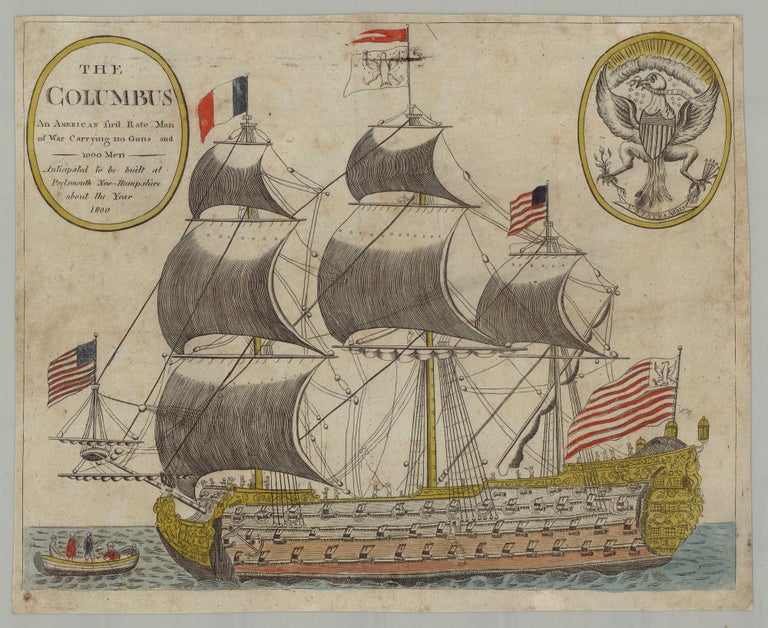The Columbus : an American First Rate Man of War Carrying 110 Guns and 1000 Men Anticipated to be Built at Portsmouth New Hampshire About the Year 1800.
[No place of publication, publisher, artist, or engraver stated, but American, circa 1799]. Hand-colored engraving, 10.75” x 13.25” plus narrow margins. CONDITION: Good, expert repairs with paper pulp to a few minor losses at edges of sheet (none affecting the image), black streak across topmost flag and various light stains throughout. An exceedingly rare American naval engraving, one of a mere handful printed in the United States in the eighteenth century, and a striking expression of Federal era patriotism, published at the height of the Quasi War. The vessel, a 110 gun man-of-war, is shown with a figurehead in the form of the head of Columbus, along with various other figural carvings about the bow and stern, numerous crewmen on the deck and on several of the yards, and flags atop each mast. A large flag with red & white stripes and featuring a Federal eagle in one corner is seen at the stern, complimented by two other American flags, one at the bow, and another atop the rear mast. An uncolored flag sporting a Federal eagle flies atop the central mast along with a red banner. The French tri-color, apparently indicating the ship’s destination, appears at the top of the foremast. A large Federal seal proudly appears in the upper right corner highlighted in yellow watercolor. In all, three American flags and three eagles are found here, and the impression is very much that of a patriotic celebration. The first attempt to establish a U. S. Navy occurred during the Revolutionary War. Eleven frigates were built, but all were either captured or destroyed by the end of the war, and the young nation was effectively without a navy for more than a decade. In response to the depredations suffered by American merchant ships at the hands of Algerine corsairs, the British, and the French, Congress passed the Naval Act of 1794, authorizing the construction of six frigates. An additional act for the augmentation of the Navy was passed in 1799, calling for six ships of war (of not less than seventy-four guns) and six sloops of war (of eighteen guns). Materials were gathered at six seaports for the construction of these vessels, but funding was insufficient and only the sloops were built. The Columbus was to be one of the seventy-fours that ultimately were not built. Just two other copies of this print are recorded, one at the Chipstone Foundation and another in the Irving Olds Collection at the New York Historical Society. The coloring of the flag atop the foremast on both examples varies. The flag on the Chipstone copy is a tri-color, but the colors are the reverse of those on the example offered here, with blue on the left and red on the right. On the Olds copy, the flag is an American flag, something evidently done at the whim of the colorist, as it is printed with three sections that more naturally conform to the tri-color. This print carries no artist, engraver or publisher credit. In his Bits and Pieces of American History, Irving Olds notes that it resembles the work of Amos Doolittle. An extremely rare and striking piece of 18th century naval Americana. REFERENCES: Olds, Bits and Pieces of American History, 374; President Washington Signs the Naval Act of 1794 at history.navy.mil; An Act for the Augmentation of the Navy, 1799 at navycs.com.
Item #7281
Sold


